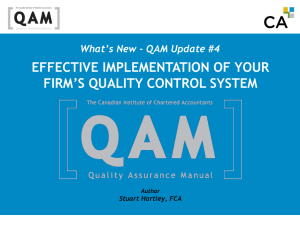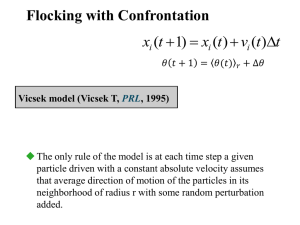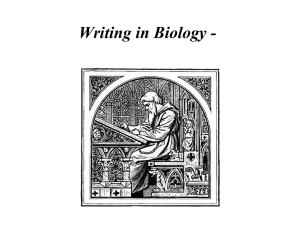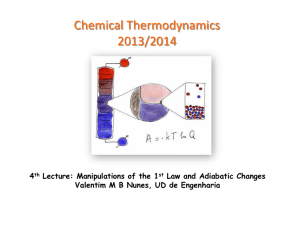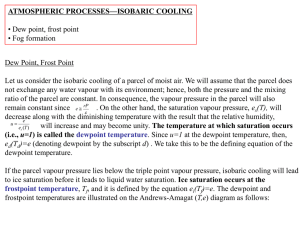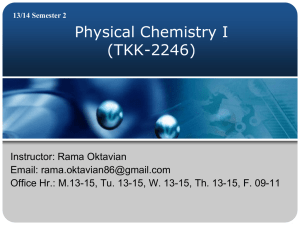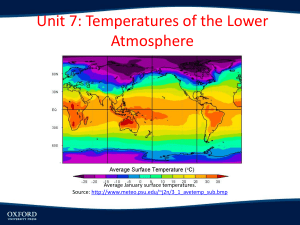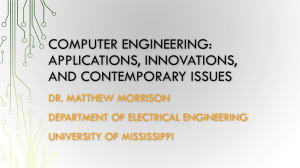Problem 1 Brayton cycle Students have made a
advertisement
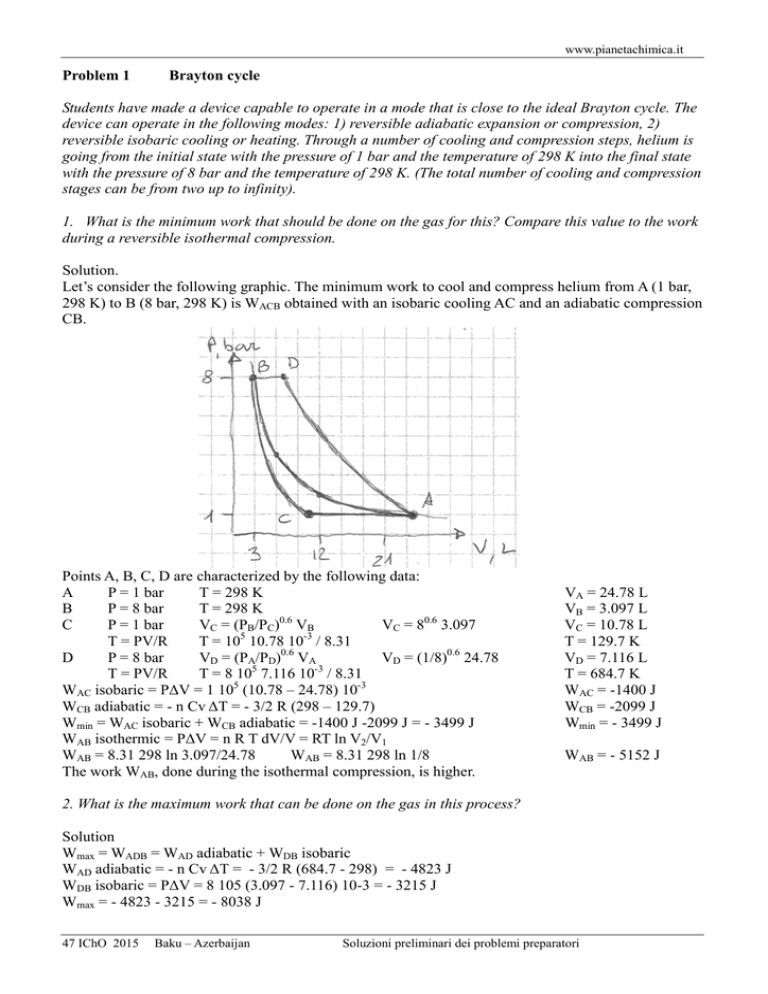
www.pianetachimica.it Problem 1 Brayton cycle Students have made a device capable to operate in a mode that is close to the ideal Brayton cycle. The device can operate in the following modes: 1) reversible adiabatic expansion or compression, 2) reversible isobaric cooling or heating. Through a number of cooling and compression steps, helium is going from the initial state with the pressure of 1 bar and the temperature of 298 K into the final state with the pressure of 8 bar and the temperature of 298 K. (The total number of cooling and compression stages can be from two up to infinity). 1. What is the minimum work that should be done on the gas for this? Compare this value to the work during a reversible isothermal compression. Solution. Let’s consider the following graphic. The minimum work to cool and compress helium from A (1 bar, 298 K) to B (8 bar, 298 K) is WACB obtained with an isobaric cooling AC and an adiabatic compression CB. Points A, B, C, D are characterized by the following data: A P = 1 bar T = 298 K B P = 8 bar T = 298 K C P = 1 bar VC = (PB/PC)0.6 VB VC = 80.6 3.097 5 -3 T = PV/R T = 10 10.78 10 / 8.31 D P = 8 bar VD = (PA/PD)0.6 VA VD = (1/8)0.6 24.78 T = PV/R T = 8 105 7.116 10-3 / 8.31 WAC isobaric = PΔV = 1 105 (10.78 – 24.78) 10-3 WCB adiabatic = - n Cv ΔT = - 3/2 R (298 – 129.7) Wmin = WAC isobaric + WCB adiabatic = -1400 J -2099 J = - 3499 J WAB isothermic = PΔV = n R T dV/V = RT ln V2/V1 WAB = 8.31 298 ln 3.097/24.78 WAB = 8.31 298 ln 1/8 The work WAB, done during the isothermal compression, is higher. VA = 24.78 L VB = 3.097 L VC = 10.78 L T = 129.7 K VD = 7.116 L T = 684.7 K WAC = -1400 J WCB = -2099 J Wmin = - 3499 J WAB = - 5152 J 2. What is the maximum work that can be done on the gas in this process? Solution Wmax = WADB = WAD adiabatic + WDB isobaric WAD adiabatic = - n Cv ΔT = - 3/2 R (684.7 - 298) = - 4823 J WDB isobaric = PΔV = 8 105 (3.097 - 7.116) 10-3 = - 3215 J Wmax = - 4823 - 3215 = - 8038 J 47 IChO 2015 Baku – Azerbaijan Soluzioni preliminari dei problemi preparatori www.pianetachimica.it 3. Let the process be accomplished in three steps. At each step helium is first cooled and then compressed. At the end of each step the pressure increases twice and the temperature returns to the value of 298 K. What is the total heat removed from the gas by a Peltier element? Solution Let’s consider the following graphic. AM-MN, NO-OR, RS-SB are the three steps of isobaric and adiabatic transformations Heat is removed only on AM, NO, RS isobaric coolings. Points N, M, R, O are characterized by the following data: N P = 2 bar T = 298 K PV = PBVB V = PB/P VB V = 8/2 3.097 0.6 M P = 1 bar V = (PN/P) VN V = 20.6 12.39 T = PV/R T = 105 18.78 10-3 / 8.31 R P = 4 bar T = 298 K PV = PBVB V = PB/P VB V = 8/4 3.097 O P = 2 bar V = (PP/P)0.6 VP V = 20.6 6.194 5 -3 T = PV/R T = 2 10 9.388 10 / 8.31 QAM = n Cp ΔT QAM = 5/2 R (225.9 – 298) QNO = n Cp ΔT QNO = 5/2 R (225.9 – 298) Qtotal = QAM + QNO + QPR = 3 1499 (heat removed from the gas during the three steps tranformation) VN = 12.39 L VM = 18.78 L T = 225.9 K VR = 6.194 L VO = 9.388 L T = 225.9 K QAM = 1499 J QNO = 1499 J Qtotal = 4497 J Once the gas is compressed, it is returned to the initial state (1 bar and 298 K) in two stages (heating and expansion). 4. What is the range of possible values of the formal efficiency η for the resulting cycle? η is the ratio of the useful work done by the gas to the amount of heat given to the gas during the heating stage. Solution η = W/QBD ηmax = Wmax/QBD Wmax = WBDACB Wmax = WBD + WDA + WAC + WCB Wmin = WBD + WDA + WAB QBD = n Cp ΔT = 5/2 R (684.7 - 298) ηmax = Wmax/QBD ηmin = Wmin/QBD 47 IChO 2015 Baku – Azerbaijan ηmin = Wmin/QBD Wmin = WBDAB Wmax = 3215 + 4823 -1400 -2099 = 8038 - 3499 = 4539 J Wmin = 3215 + 4823 - 5152 = 8038 - 5152 = 2886 J QBD = 8038 J ηmax = 4539/8038 = 0.565 ηmin = 2886/8038 = 0.359 Soluzioni preliminari dei problemi preparatori www.pianetachimica.it 5. In one of the experiments, the gas has been compressed from 1 bar and 298 K to 8 bar and 298 K in several steps (like in question 3). At the end of each step the pressure is increased by x times and the temperature returns to 298 K. Then helium has been returned to the initial state in two stages – heating and expansion. Theoretical value of η for this cycle is 0.379. How many steps were used? Solution In this cycle, named X, we have η = 0.379 η = Wdone/Qabsorbed Wdone = η Qabsorbed Wdone = 0.379 8038 = 3046.4 J Wdone = WBD + WDA + Wx Wx = Wdone - WBD - WDA Wx = 3046.4 - 8038 = - 4992.4 J Wx = recharge work in cycle X The equation that links the increment of pression x to the number of cycles n is: xn = 8 x = 81/n In question 3 we had three cycles so n = 3 and x = 2. In fact we had PA = x0 = 20 = 1 bar PN = x1 = 21 = 2 bar PR = x2 = 22 = 4 bar PB = x3 = 23 = 8 bar WAMN = QAM Points N, M, O, R are characterized by the following data: M P = x0 bar VM = (PN/PM)0.6 VN VM = (x1/x0)0.6 8/x 3.097 L VM = x0.6 8/x 3.097 L T = PV/R = x0 x0.6 8/x 3.097 102/R TM = x0.6 8/x 3.097 102/R 1 N P = x bar VN = PB/PN VB VN = 8/x 3.097 L TN = TA = 298 K 1 0.6 2 1 0.6 2 O P = x bar VO = (PR/PO) VR VO = (x /x ) 8/x 3.097 L VO = x 0.6 8/x2 3.097 VO = VM/x T = PV/R = x x0.6 8/x2 3.097 102/R 0.6 2 T = x 8/x 3.097 10 /R TO = T M M, O, S are on the same isotherm R P = x2 bar VR = PB/PR VB VR = 8/x2 3.097 L QAM = 1 mol Cp ΔT = 5/2 R (TM - TA) = 5/2 R (x0,6 8/x 3.097 102/R - 298) QAM = 6194 (x–0.4 – 1) J 1/n –0.4 1/n where x = 8 then QAM = 6194 (8 ) – 1) remember that T M = TO = T S ΔT is always the same, then QAM = QNO = QRS = ... etc Wtotal AMNORS...B = Wx = n QAM The equation becomes n QAM = - 4992.4 J n 6194 [(8–0.4)1/n – 1] = - 4992.4 –0.4 1/n n [(8 ) – 1] = - 0.806 Solving this equation we obtain n = 13 The number of cycles that produces η = 0.379 is 13. In fact, Peltier elements also consume electric energy during the cooling stage. Assume that they consume as much energy as is removed from the gas. 6. What is the maximum possible efficiency of the considered cycle, taking into account energy consumption during cooling? Solution Useful work = WBDA = 8038 J Minimum work to close the cycle = WACB = -3499 J Energy requested to extract heat = QACB = WACB = -3499 J Heat given to the gas during isobaric heating BD = QBD = WBDA = 8038 J Maximum formal efficiency of the cycle = η = (WBDA + WACB + QACB) / QBD η = (WBDA + 2 WACB) / WBDA η = (8038 - 2 3499) / 8038 η = 0,129 Solution proposed by Mauro Tonellato – Chemistry teacher – ITI Marconi – Padova – Italy 47 IChO 2015 Baku – Azerbaijan Soluzioni preliminari dei problemi preparatori
